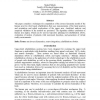Free Online Productivity Tools
i2Speak
i2Symbol
i2OCR
iTex2Img
iWeb2Print
iWeb2Shot
i2Type
iPdf2Split
iPdf2Merge
i2Bopomofo
i2Arabic
i2Style
i2Image
i2PDF
iLatex2Rtf
Sci2ools
ROBOTICA
2006
2006
Human arm kinematics for robot based rehabilitation
The paper considers a technique for computation of the inverse kinematic model of the human arm for robot based rehabilitation that uses measurements of the hand position and orientation and radial acceleration of the upper arm. Analytical analysis and empirical validation of the method are presented. The algorithm enables estimation of human arm angles, which can be used in trajectory planning for rehabilitation robots, evaluation of motion of patients with movement disorders, and generation of virtual reality environments.
| Added | 15 Dec 2010 |
| Updated | 15 Dec 2010 |
| Type | Journal |
| Year | 2006 |
| Where | ROBOTICA |
| Authors | Matjaz Mihelj |
Comments (0)

